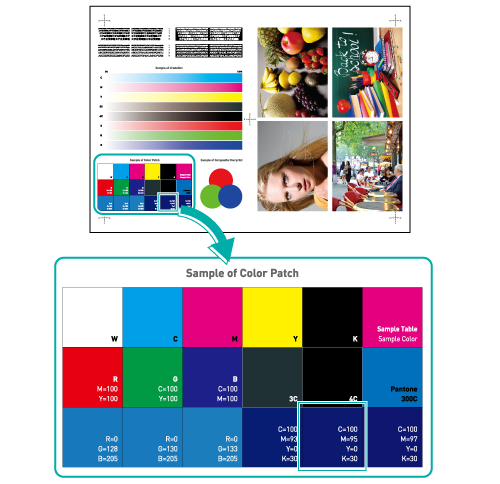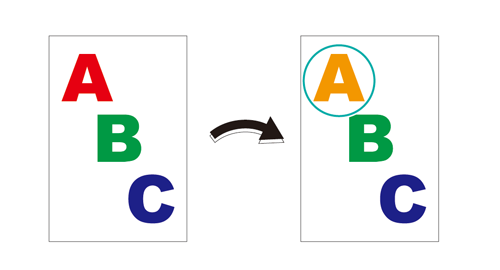Image Quality: Registering an Alternative Color (CMYK -> CMYK)
You can use Color Centro to register a new alternative color. By enabling the alternative color setting of the printer driver when printing, you can print using alternative colors.
This section introduces how to register the following alternative color for the original CMYK color and how to print upon replacing the color.
• Original color: C=100 / M=95 / Y=0 / K=30
• Alternative color: M=100 / Y=100 (red)
The example in this section is for cases where the original color is a CMYK color. If the color to be replaced is an RGB color, refer to Image Quality: Registering an Alternative Color (RGB -> CMYK).
Using sample data (sample B), you can check the procedure during the actual operation.

• Meaning and Purpose of Alternative Colors
With the image controller, you can replace any given RGB color or CMYK color with another predefined CMYK color (alternative color) for printing. The original color and the corresponding alternative color are defined in an alternative color table.

Using Color Centro, you can create, register and edit new alternative colors.
Alternative colors are primarily used to change the colors of an illustration or text.
• When to perform
When you want to replace a certain CMYK color in the original with a different CMYK color
•Intended Environment
Operating system | Windows 7 |
Application | Color Centro 2.0 / Adobe Acrobat X Pro |
Image Controller | Image Controller IC-602 |
Printer driver | PS Plug-in Driver |
* The sample screen may be different from the actual display depending on your system environment and application version/revision.
•Samples
Sample B (B_sample.pdf)
Provided in the "/contents/sample/" folder on the accompanying CD-ROM.
•Workflow

• Related Section
•Precautions
The specified original colors are all replaced by their corresponding predefined alternative colors. Check that the texts, graphics, or images that you want to print in their original colors do not include the colors specified to be replaced by alternative colors.
To reproduce stable colors, in addition to regular calibration, make other pre-output image quality adjustments as necessary, such as when changing screens or papers or when hue is important. For details, refer to Pre-output Image Quality Adjustment.

